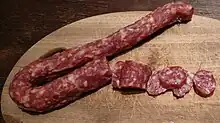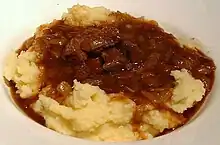Dutch cuisine
Dutch cuisine (Dutch: Nederlandse keuken) is formed from the cooking traditions and practices of the Netherlands. The country's cuisine is shaped by its location in the fertile North Sea river delta of the European Plain, giving rise to fishing, farming (for crops, dairy and meat) and overseas trade. The Burgundian-Habsburg court enriched the cuisine of the Dutch elite in the 15th and 16th century, so did the colonial spice trade in the 17th century.
In the 17th and 18th century, Dutch cuisine played a pivotal role in the spread of coffee in the world as the Netherlands pioneered in establishing gardens for coffee cultivation in their colonies and popularising the concept of coffeehouses for the masses.[1] And the development of the Dutch process chocolate in 1828, which was instrumental in the transformation of chocolate to its solid form (which was up till then drunk as a liquid), started the modern era of chocolate.[2]
In the late 19th and early 20th centuries, Dutch food became designed to be economical and filling rather than pleasing,[3] which was the result of the rise of housekeeping schools, where girls learned to cook in such manner. Also, Dutch food production focussed increasingly on efficiency, which became so successful, that despite its size, the small country became the world's second largest exporter of agricultural products by value behind the United States.[4] Due to this focus on efficiency, the Dutch obtained not only a reputation that they were feeding the world, but also that their cuisine had a bland taste.[3]
Due to the availability of water and flat grass land, The Dutch diet contains many dairy products, such as cheese, and is relatively high in carbohydrates and fat. During the 20th century, Dutch cuisine and diet changed significantly. Initially influenced by the eating culture of its colonies (particularly the Dutch East Indies), and later by globalization, it became cosmopolitan. Most international cuisines are represented in the major cities and there is a renewed interest in pleasing tastes.
History
12th–13th centuries
Little written evidence is available about food and drink in the late medieval Low Countries. Fortunately, many cookbooks have survived from Germany (from 1350), Norway (mid-14th century), England, France and Italy. They picture a homogeneous food culture in Europe. This is because the surviving cookbooks were written for and by the elite, who traveled with their cooks throughout Europe, and exchanged dishes among themselves.[5]
Differences were mainly in the use of products: the locally available vegetables for example. Milk and butter—coming from the low-lying grasslands of Holland and Friesland—were used extensively in the Netherlands, in comparison German countries and England where bacon fat was extensively used, or Southern Europe where predominantly oil was used. Moreover, Dutch butter and cheese became famous products at an early stage and continued to be so for centuries.[6]
The common people also ate a lot of dough and grain products, although it was often in the form of a half-liquid brij (porridge). Potages were also popular: one-pan dishes with various (root) vegetables, peas, possibly herbs, meat and fish. Soppes were also eaten: a kind of thick vegetable/meat/fish paste that was thickened with bread or poured over bread. The content changed throughout the seasons.[6]
Beer was in medieval times the common drink as water was of poor quality.[7] It was flavoured with gruit and produced until the 14th century at the monasteries. Gruit was replaced with hop, a tradition introduced from the German city of Bremen. Beer brewed with hop had a much longer shelf life. This started off a beer culture based on hop, and the Low Counties as a major exporter of beer that remained until today, as the Netherlands is still the largest beer exporter of Europe.[8]
14th–16th centuries
The sea and the rivers provided an abundance of fish. The process of gibbing was invented by Willem Beukelszoon,[9] a 14th-century Zealand fisherman. The invention extended the shelf life of herring, which made it possible to sail further and catch more. It created an booming export industry for soused herring (Dutch: maatjesharing) that was monopolized by the Dutch. They began to build bigger ships and eventually moved from trading in herring to a multitude of exclusive products like exotic spices, ultimately leading to the Dutch becoming a seafaring and colonial power.[10] Herring is still very important to the Dutch who celebrate Vlaggetjesdag (Flag Day) each spring, as a tradition that dates back to the 14th century when fishermen went out to sea in their small boats to capture the annual catch (Hollandse Nieuwe), and to preserve and export their catch abroad.[11]
Gardening was initially practiced by monasteries, but castles and country houses began also to develop gardens with herbs and vegetables and hunting grounds. The famous tourist attraction and flower park Keukenhof (literally kitchen garden) is an example of a former 15th-century hunting ground and herbs garden for Jacqueline, Countess of Hainaut's castle kitchen. Orchards for pears and apples connected to castles were later used for export and set off a Dutch horticulture tradition that remains to this day.[6]
During the 15th century haute cuisine began to emerge, largely limited to the aristocracy. Cookery books from this period are aimed at the upper class. The first Dutch-language cook book printed in Brussels is called Een notabel boecxken van cokeryen (A notable book of cookery) from ca. 1510.[12] It offers medieval recipes for festivities, such as sauces, game, jellies, fish, meat, pies, eggs, dairy products, candied quinces and ginger and contains one of the oldest known recipes for appeltaerten, apple pie. The recipes come from various sources, 61 of them are translations of the French recipe book Le Viandier.[13]
Historically, Dutch cuisine was closely related to northern French cuisine, since the two countries have nearby borders and the Low Countries and Northern France have been historically ruled by the Dukes of Burgundy, who established in the Burgundian Netherlands a glamorous court life with lavish feasts. This is still visible in traditional Dutch restaurants and particularly the Southern regional cuisine, that is colloquially referred to as Bourgondisch.[6]
17th century
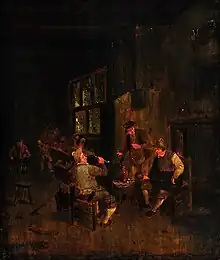
As the Dutch Republic entered its Golden Age in the 17th century, dishes of this kind became available to the wealthy middle class as well, often consisting of a rich variety of fruits, cheeses, meat, wine, and nuts.[14][15] The Dutch Empire enabled spices, sugar, and exotic fruits to be imported to the country. By 1662, the Dutch provided more than half of the refined sugar consumed in Europe[16] and monopolised the trade in spices such as nutmeg, clove, mace and cinnamon.[17] The large supply of spices made them affordable for the Dutch middle class. In the Middle Ages, spices were largely used to indicate social status. This disappeared with this new development in Dutch society and it was the elite who were the first to ban the frequent use of spices. The cookbook De Verstandige Kok (or The Reasonable Chef) published in 1667, reflects this and shows the great interest the elite had in what was on the plates.[3][18]
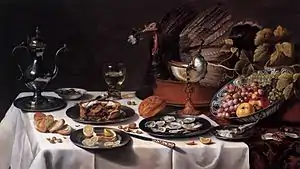
The Dutch East India Company was the first to import coffee on a large scale to Europe and popularised the concept of coffee houses.[19] The Dutch later grew the crop in Java and Ceylon.[20] The first exports of Indonesian coffee from Java to the Netherlands occurred in 1711.[21] By the late 17th century, tea and coffee consumption were increasing and becoming part of everyday life. Tea was served with sweets, candy or marzipan and cookies. The availability of relatively cheaper spices resulted in a tradition of spiced cookies called speculaas, the exact recipes of which were kept secret by bakers.[22]
Vegetables, meat, poultry and salted, smoked or fresh fish and eggs were prepared in the Dutch kitchens of the time.[23] The meal started with green salads and cold or warm cooked vegetables with dressing, vegetable dishes with butter, herbs or edible flowers and continued with numerous fish and meat dishes.
Exotic ingredients such as dates, rice, cinnamon, ginger and saffron were used. Savoury tarts and pastries followed. The meal ended with jellies, cheese, nuts and sweet pastries, washed down with hippocras, a sweet spiced wine.[24] Of course, even in the Golden Age, not everyone could afford such luxuries and the everyday meal of the ordinary Dutchman was still a humble affair of grain or legume pottage served with rye.[25]
- Dutch Golden Age – historical cuisine
 Kitchen scene from 1644, with swan pie, game, fish and apples, by David Teniers the Younger
Kitchen scene from 1644, with swan pie, game, fish and apples, by David Teniers the Younger'_by_Pieter_Claesz.%252C_Cincinnati.jpg.webp) Mince pie and Lemon by Pieter Claesz, 1625
Mince pie and Lemon by Pieter Claesz, 1625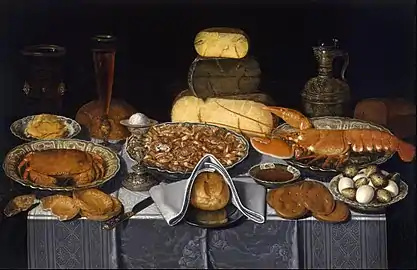 Clara Peeters (1594–1657) Still Life with Crab, Shrimps and Lobster
Clara Peeters (1594–1657) Still Life with Crab, Shrimps and Lobster.jpg.webp) Clara Peeters (1594–1657) Table with Orange, Olives and Pie
Clara Peeters (1594–1657) Table with Orange, Olives and Pie Clara Peeters (1594–1657) Still life with Cheeses, Artichoke, and Cherries
Clara Peeters (1594–1657) Still life with Cheeses, Artichoke, and Cherries Still-Life with fruit, nuts and cheese by Floris Claeszoon van Dyck
Still-Life with fruit, nuts and cheese by Floris Claeszoon van Dyck
18th–19th centuries

In the late 18th century the potato was introduced from South America and became a staple food by 1800.[26] In the early 19th century, while the rich could eat what they desired, the working population ate bread (rye bread in some areas) and potatoes (often eaten at every meal of the day[26]), pancakes in some areas, occasionally fish (herring) and other seafood, fruit and vegetables, but usually little meat. Throughout the 19th century working class people suffered from some form of malnutrition.[26]
During the 19th century, the poor people drank little else but water (of poor quality), sometimes watery coffee (or chicory) or tea. In some areas hot chocolate was consumed, but the most popular drinks (beside water) were beer and jenever. For most of the century beer was drunk in the southern part, where Catholicism dominated, and in Catholic enclaves in the other areas. Jenever consumption early in the 19th century was twice that of the equivalent consumption of distilled spirits in neighbouring countries.[26]
20th–21st centuries
The modest and plain look of what is nowadays considered the traditional Dutch cuisine, appears to be the result of a fairly recent development. In the twentieth century, the new availability of mass education meant that a great number of girls could be sent to a new school type, the Huishoudschool (housekeeping school), where young women were trained to become housewives and where lessons in cooking cheap and simple meals were a major part of the curriculum, often based on more traditional Dutch dishes, and leading to increased uniformity in the Dutch diet. Values taught in that school system included frugality, proper table manners, and healthy eating.
Origins
Dutch agriculture roughly consists of five sectors: tillage-based, greenhouse-based, fruit agriculture, animal husbandry and fishery.
- Tillage-based crops include potatoes, kale, beetroot, green beans, carrots, celeriac, onions, all the common kinds of cabbages, Brussels sprouts, cauliflower, endive, spinach, Belgian endive, asparagus and lettuce. Recently some initiatives have been started to encourage interest in such "forgotten" vegetables as common purslane, medlars, parsnips, and black salsify.
- Greenhouses are used to produce tomatoes, lettuce, cucumbers, and sweet peppers.
- Fruits include apples, pears, cherries, berries, and plums.
- The Dutch keep cattle for milk, butter, cheese, and for their meat, chickens for their eggs and for meat, pigs for their meat and a variety of non-edible products, and sheep for their wool and meat. Goats are increasingly kept for cheese production. Traditionally horse meat was a common dish (steak, sausage, and thinly-sliced smoked meat), but it is less popular today.
- The fishery sector lands cod, herring, European plaice, sole, mackerel, eels, tuna, salmon, trout, oysters, mussels, shrimp, and sardines. The Dutch are famous for their smoked eel and soused herring, which is eaten raw.
Regional
Many food origins can be traced back to one of the three general regional forms of Dutch cuisine.[27] Some agricultural products and foodstuffs from these regions are protected by EU law as Protected designation of origin, like jenever, Noord-Hollandse Gouda, and kanterkaas (cumin cheese and clove cheese), Traditional speciality guaranteed, like boerenkaas (farmhouse cheese) and Hollandse nieuwe (soused herring), and the less strict variant of Protected geographical indication, like Edam Holland and Limburgse vlaai.
Northeastern cuisine
The regions in the north and east of the Netherlands, roughly the provinces of Groningen, Friesland, Drenthe, Overijssel and Gelderland north of the great rivers make up north eastern Dutch cuisine.
The region is the least populated area of the Netherlands. The late (18th century) introduction of large scale agriculture means that the cuisine is generally known for its many kinds of meats. The relative lack of farms allowed for an abundance of game and husbandry, though dishes near the coastal regions of Friesland, Groningen and the parts of Overijssel bordering the IJsselmeer also include a large amount of fish.
The various dried sausages, belonging to the metworst-family of Dutch sausages, are found throughout the region and are highly prized for their often very strong taste. Most towns and various villages have their own variety of this sausage. The region also produces the traditional smoked sausages, of which (Gelderse) rookworst is the most renowned. These sausages traditionally have been smoked over wood chips, and are served after they have been boiled in water. The sausage contains a lot of fat and is very juicy. The large sausage are often eaten alongside stamppot, like zuurkoolstamppot (mashed potatoes and sauerkraut). Cut in half they are sometimes eaten as a street food. In Gelderland (in and around the Veluwe) and Overijssel (in Salland) kruudmoes is a traditional food with buttermilk, pearl barley, bacon and herbs in which rookworst is processed.
The provinces are also home to many kinds of pastries, cookies and (rye) breads. Each of the provinces of Gelderland, Overijssel and Groningen has a long-standing rye bread tradition, but rye bread from Friesland (a kind of Pumpernickel) became well known because of its taste. Notable characteristics of Frisian rye bread is its long baking time (up to 20 hours), resulting in a sweet taste and a deep dark color. In contrast to southern Dutch cuisine, which tends to be soft and moist, the northeastern rye bread and pastries generally are of a hard texture, and the pasties are heavily spiced with ginger or succade or contain small bits of meat. Examples of these that are considered typical for the region are Kruidkoek (such as Groninger koek), Frisian Suikerbrood (with chunks of sugar), Fryske dúmkes (cookies with anais, ginger, and hazelnuts) and spekdik (small pancakes with metworst and bacon).
In terms of alcoholic beverages, the region is renowned for its many bitters (such as Beerenburg) and other high-proof liquors rather than beer, which is, apart from Jenever, typical for the rest of the country.
As a coastal region, Friesland is home to low-lying grasslands, and thus has a cheese production in common with the Western cuisine. Friese Nagelkaas (Friesian Clove cheese) is a notable example, and the variant made with skimmed milk known as kanterkaas, is a protected designation of origin.
Western cuisine
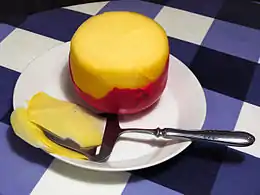
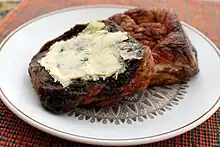
The provinces of North Holland, South Holland, Zeeland, Utrecht and the Gelderlandic region of Betuwe are the parts of the Netherlands which make up the region in which western Dutch cuisine is found.
Due to the abundance of surface water and grassland, necessary to sustain dairy cattle, the area is known for its many dairy products, which for centuries includes prominent Dutch cheeses such as Gouda, Leyden (spiced cheese with cumin) and Edam (traditionally in small spheres), as well as relatively new trademarked cheese brands such as Leerdammer, and Beemster. Zeeland and South Holland produce a lot of butter, which contains a larger amount of milkfat than most other European butter varieties. A by-product of the butter-making process, buttermilk (karnemelk), is also considered typical for this region.
Seafood such as soused herring, mussels (called Zeeuwse Mosselen, since all Dutch mussels for consumption are cleaned in Zeeland's Oosterschelde), eels, oysters and shrimps are widely available and typical for the region. Kibbeling, once a local delicacy consisting of small chunks of battered white fish, has become a national fast food, just as Lekkerbekje.

Indirectly a product of the sea is Ossenworst (''ox sausage''), a raw beef sausage originating in Amsterdam, which used to be made of ox meat. This specialty has its origins in the seventeenth century, when oxen were imported large-scale from Denmark and Germany. The spices in the sausage, such as pepper, cloves, mace and nutmeg, came from the Dutch East Indies. Traditionally, aged beef was used for this sausage, that was then smoked at a low temperature such that the meat remained raw. Present-day Amsterdam ossenworst is made with lean beef, and the sausage is now often neither smoked nor aged. It is often eaten with Amsterdamse uitjes, a kind of pickled onion.
Pastries in this area tend to be quite doughy, and often contain large amounts of sugar; either caramelised, powdered or crystallised. The oliebol (in its modern form) and Zeeuwse bolus are good examples. A moist doughy white bread from the Zaanstreek in North Holland is duivekater, of which the recipe goes back hundreds of years and is eaten with butter. Cookies of all sorts are produced in great number and tend to contain a lot of butter and sugar, of which the stroopwafel is well known, just as cookies with a filling of some kind, mostly almond, like gevulde koek.
The region is also known for its chocolate industry, due to its colonial past, and the development of the Dutch process chocolate in 1828 by Coenraad van Houten, that started the modern era of chocolate as it was instrumental in the transformation of chocolate to its solid form which was up till then drunk as a liquid. Van Houten produced chocolate in Amsterdam, later in Leiden and Weesp, while Droste started in Haarlem. The popular chocomel started the production in Zoetermeer, and is a trademarked chocolate-flavoured milk, often the choice of drink as Koek-en-zopie, the food and drink sold on the ice during periods of ice skating. Verkade has its chocolate production in Zaandam. The same city is home to the headquarters of a new Dutch fair trade chocolate brand that took the market by storm: Tony's Chocoloney. Zaanstreek is since the 16th century also known for its mayonnaise (for the Dutch a popular condiment to eat with French fries), and typical whole-grain mustards (popular to eat with bitterballen).
The traditional alcoholic beverages of this region are beer (strong pale lager) and Jenever, a high proof juniper-flavored spirit, that came to be known in England as gin. A noted exception within the traditional Dutch alcoholic landscape, Advocaat, a rich and creamy liqueur made from eggs, sugar and brandy, is also native to this region.
Southern cuisine
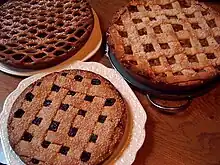
Southern Dutch cuisine constitutes the cuisine of the Dutch provinces of North Brabant and Limburg and the Flemish Region in Belgium. It is renowned for its many rich pastries, soups, stews and vegetable dishes and is often called Burgundian which is a Dutch idiom invoking the rich Burgundian court which ruled the Low Countries in the Middle Ages renowned for its splendor and great feasts.
It is the only Dutch culinary region which developed an haute cuisine and it forms the base of most traditional Dutch restaurants including typical main courses served such as Biefstuk, Varkenshaas, Ossenhaas, these are premium cuts of meat, generally pork or beef, accompanied by a wide variety of sauces and potatoes which have been double fried in the traditional Dutch (or Belgian) manner.
Stews, such as hachee, a stew of onions, beef and a thick gravy, contain a lot of flavour and require hours to prepare. Vegetable soups are made from richly flavored stock or bouillon and typically contain small meatballs alongside a wide variety of different vegetables. Asparagus and witloof are highly prized and traditionally eaten with cheese or ham.
Pastries are abundant, often with rich fillings of cream, custard or fruits. Cakes, such as the Vlaai from Limburg and the Moorkop and Bossche Bol from Brabant, are typical pastries. Savoury pastries also occur, with the Brabantian worstenbroodje (a roll with a sausage of ground beef, literally translates into sausage bread) being the most popular.
The traditional alcoholic beverage of the region is beer. There are many local brands, ranging from Trappist beer to Kriek lambic. 5 of the 11 International Trappist Association-recognised breweries in the world, are located in the Southern Dutch cultural area. Beer, like wine in French cuisine, is also used in cooking; often in stews.
Colonial

Indonesian
Indonesian and Indo dishes became popular due to the arrival of former Dutch colonials and people of Eurasian descent into the Netherlands, especially after the independence of Indonesia from Dutch colonial rule in 1945. Countess van Limburg Stirum writes in her book The Art of Dutch Cooking (1962): "There exist countless Indonesian dishes, some of which take hours to prepare; but a few easy ones have become so popular that they can be regarded as 'national dishes'". She then provides recipes for nasi goreng (fried rice), pisang goreng (fried bananas), lumpia goreng (fried spring rolls), bami (fried noodles), satay (grilled skewered meat), satay sauce (peanut sauce), and sambal oelek (chilli paste).[28] Of the Dutch-Indonesian fusion dishes the best known is the rijsttafel ("rice table"), which is an elaborate meal consisting of many (up to several dozen) small dishes filling an entire table. While still popular in the Netherlands, rijsttafel is now rare in Indonesia itself.
Outside the big cities, Indonesian food is served in Chinese restaurants, and almost every town in the Netherlands has a Chinese-Indonesian (Chinees-Indische) restaurant. This typical Dutch restaurant fusion is now heavily in decline. In February of 2021, this Chinese-Indonesian restaurant culture - where three cultures come together (Chinese, Indonesian and Dutch) - has been acknowledged as Dutch intangible cultural heritage, that needs to be preserved.[29]
Popular fusion dishes sold at snackbars are patatje oorlog (French fries with mayonaise, onions and peanut sauce) and patatje pinda (French fries with peanut sauce).[30]
Another food with Indonesian roots sold in wide varieties in supermarkets across the country is krupuk.
Surinamese and Caribbean
Surinamese cuisine is also popular in the Netherlands, especially in the bigger cities. Surinamese establishments commonly offer roti, a staple of the Hindustani community in Suriname, various Surinamese interpretations of Chinese Indonesian cuisine, and Surinamese sandwiches (Surinaamse broodjes) such as broodje bakkeljauw (with a type of dried and salted cod) and broodje pom.
International
Italian and American style pizzerias have become widespread, as have American fast food restaurant chains. In recent decades, Arab and Turkish dishes have become increasingly popular as well, especially as a snack food. In larger towns and cities, small restaurants selling kebabs, shawarma, and falafel can be found on virtually any street corner. In the bigger cities foods from all corners of the globe are sold in shops and restaurants.
Structure of meals
Breakfast
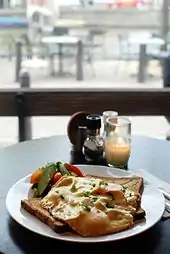
Alongside yoghurt, fruit and muesli, ontbijt (breakfast) consists of bread, usually with butter and sweet toppings, such as hagelslag, vlokken, muisjes, vruchtenhagel, gestampte muisjes, treacle, apple butter, kokosbrood, jam, chocolate spread, and speculaas.
Dutch bread tends to be very airy, as it is made from yeast dough. From the 1970s onward Dutch bread became predominantly whole-grain, with additional seeds such as sunflower or pumpkin seeds often mixed with the dough for taste. Rye bread is one of the few dense breads of the Netherlands. White bread used to be the luxury bread, often made with milk as well as water. A typical Dutch white bread is tiger bread. Ontbijtkoek may be eaten as a substitute for a full breakfast, or simply as a snack. It is served as a thick slice, usually with butter.
Beschuit (Dutch crisp bakes) is also eaten as a breakfast food, with the same variety of sweet toppings, or cheese. A longtime Dutch (romantic) favourite is to serve strawberries on beschuit, which is usually topped with some sugar or whipped cream.
A popular breakfast in the weekend are pannenkoeken (large and thin pancakes) with apples, cheese, or raisins. Sometimes pannenkoeken are eaten as dinner in a pannenkoekenhuis (restaurant), and the variety of toppings can include bacon, ragout and many other things. Wentelteefjes (French toast) is another breakfast treat.
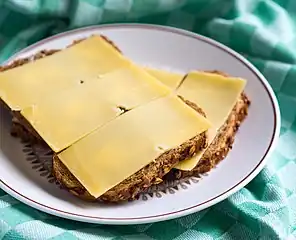 A boterham met oude kaas (sandwich with "old" cheese)
A boterham met oude kaas (sandwich with "old" cheese)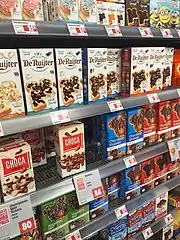 Hagelslag, muisjes and vlokken on display in a Dutch supermarket.
Hagelslag, muisjes and vlokken on display in a Dutch supermarket. Kruidkoek, peperkoek, and ontbijtkoek are a few of the regional names for a local version of gingerbread.
Kruidkoek, peperkoek, and ontbijtkoek are a few of the regional names for a local version of gingerbread.
Lunch
Middageten or lunch is somewhat similar to breakfast, but is usually heavier, less sweet, and more savory. However, lunch is not to be a warm meal, and eating leftovers for lunch is not very common. In bars and restaurants however, uitsmijter is a popular dish: two eggs fried with bacon or Gouda cheese, rosbief (rare roast beef, thinly cut), ham. Popular bread toppings when eating lunch at home include pindakaas (peanut butter), filet americain (a finely ground raw lean beef with the addition of mayonnaise, mustard, paprika and other spices), a wide variety of cold cuts and - where the Dutch are well known for - cheeses. The vast majority of Dutch cheeses are semi-hard or hard cheeses. Famous Dutch cheeses, include Gouda, Edam, and Leyden. A typically Dutch way of making cheese is to blend in herbs or spices during the first stages of the production process. Famous examples of this are cheeses with cloves (usually the Friesian Clove), cumin (most famously Leyden cheese), or nettles.
Dutch hard cheeses generally can be divided by maturity:
| Dutch name | English | Maturity | Flavour | Texture |
|---|---|---|---|---|
| Jonge kaas | young | 4 weeks | creamy | soft |
| Jong belegen | young matured | 8-10 weeks | mild | soft |
| Belegen | matured | 16-18 weeks | full | semi hard |
| Extra Belegen | extra matured | 7-8 months | spicy | semi hard |
| Oude kaas | old | 10-12 months | rich and spicy | hard |
| Overjarig | very old | 1-2 years | rich and salty | crumble with salt crystals |
However, the terms 'jong', 'belegen', old, etc. have not been legally established with regard to the period of ripening, and the majority of cheeses sold in supermarkets have been produced with a fast-ripening starter, which, as a drawback, adds a sweeter flavour to the cheese. For example, Old Amsterdam has crystals of an old cheese, but it is ripened - according to the company - only for 8 months.[31]
Coffee break and sweets
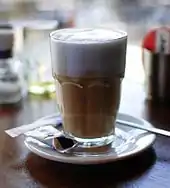
Dutch people invite friends over for koffietijd (coffee time), which consists of coffee and cake or biscuits, served between 10:00 and 11:00 am (before lunch), 4:00 pm (between lunch and dinner) or between 7:00 pm and 8:00 pm (after dinner). Dutch thrift of the 1940's and 1950's, when the country was rebuilding the destruction of World War II, led to the famous standard rule of only one cookie with each cup of coffee. Presumably in the late 1940's even the then Prime Minister, Willem Drees, served coffee and one biscuit to a visiting American diplomat, who then became convinced that the money from the Marshall Plan was being well spent. It has been suggested that the reasons for this can also be found in the Protestant mentality in the northern Netherlands. The Roman Catholic south does not share this tradition as for instance in Limburg, where serving a large vlaai (sweet pie or pastry with filling), cut into eight pieces, is tradition when visitors are expected.
Koffie verkeerd (literally "wrong coffee"), or Café au lait, consists of equal parts black coffee and hot milk. The Dutch drink tea without milk and the tea is quite a lot weaker than typical English or Irish types of tea which are stronger and are usually taken with milk. In Dutch bars, tea with freshly chopped ginger (verse gemberthee) or with fresh mint leaves (verse muntthee) is very popular. In the autumn and winter hot chocolate or chocomel is drunk. Two other traditional Dutch drinks, anijsmelk (hot milk with aniseed) and kwast (hot water with lemon juice)[32] are hardly drunk any more.
The drinks are served with a wide variety of cakes (gebak), cookies (koekjes) and candies (snoep).
Gebak
- Appeltaart (kind of apple pie): Traditional Dutch apple pie comes in two varieties, a crumb (appelkruimeltaart) and a lattice (appeltaart) style pie. Both recipes are distinct in that they typically call for flavourings of cinnamon, nutmeg and lemon juice to be added and differ in texture, not taste. Dutch apple pies include also ingredients such as full-cream butter, sugar, and optionally raisins and almond paste (placed as a layer between the apples and the crust, so the moist of the apple does't reach the crust). Two Dutch apple cultivars are used: either the soft and sweet sour Goudreinet or the crisp and sweet Elstar, depending on the preference. Sometimes a small pear is added tot the mixture. It can be eaten warm or cold, with a dash of whipped cream or vanilla ice cream. In the US, "Dutch apple pie" refers specifically to the apple pie style with a crumb topping.
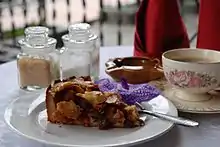 Appeltaart, Dutch apple pie
Appeltaart, Dutch apple pie - Boterkoek
- Mergpijp
- Moorkop and related Bossche bol
- Tompouce: In the Netherlands, the tompoes is iconic, and for novices to the pastry difficult to eat.
- Vlaai (made with a yeast dough and filled with fruit such as apple, apricot, pineapple, plum, cherrie or berry filling. Other ingredients include custard and rhubarb. Rijstvlaai, stuffed with a rich rice-and-cream filling, and kruimelvlaai,, stuffed with custard an sprinkled with crumbs are also popular. They can be additionally grafted with fruits, whipped cream or chocolate.)
Koekjes
- Stroopwafel (Thin waffle cookie, made in a pizelle pan, is sliced horizontally and used for sandwiching a layer of syrup)
 Stroopwafels consisting of waffles with caramel-like syrup filling.
Stroopwafels consisting of waffles with caramel-like syrup filling. - Speculaas
.jpg.webp) Speculaas is reminiscent to the Dutch 16th-17th c. spice trade.
Speculaas is reminiscent to the Dutch 16th-17th c. spice trade. - Gevulde koek (pastry filled with almond paste)
- Bitterkoekje
- Krakeling (kind of kringle)
- Kletskopje
- Bokkenpootjes
- Spekkoek (originally from Indonesia)
- Sprits
- Fryske dúmkes
- Roze koek
- Groninger koek
- Janhagel
- Jan in de zak
- Ketelkoek
- Krentenwegge (kind of raisin bread)
- Kruidkoek
- Kokoskoek
- Oudewijvenkoek
- Gemberkoek
- Ontbijtkoek
- Rijstekoekje
- Dikke koek
Snoep
- Drop (liquorice); The Dutch are the highest consumers of liquorice in the world.[33] The four types of drop are soft sweet (including fruitdrop), soft salt, hard sweet (katjesdrop), and hard salty (zoute snippers). Zoute drop, or salty liquorice comes in regular and double salty. When they are flavoured with coconut fondant they are called Engelse drop (liquorice allsorts). Other varieties are made with honey (honingdrop), salmiac (salmiakdrop), or bay laurel (laurierdrop). Typical shapes of Dutch drop are diamonds, ovals, oblongs, and coins (known as munten in Dutch, leading to the name muntdrop). Some manufacturers have introduced speciality ranges where the drop is made in thematic shapes, the most notable are shapes of cars (autodrop), and shapes of farm animals and farm machinery (boerderijdrop).
 Griotten, a type of soft sweet Dutch liquorice
Griotten, a type of soft sweet Dutch liquorice - Chocolade (chocolate)
- Hopje
Borreltijd and savouries
Between 5:00 pm and 9:00 pm it is time for an alcoholic beverage (borrel), beer or wine, and a savory snack. This is when the famous bitterballen are served, a miniature variant of the kroket (croquette), deep-fried ragout-filled balls with a crunchy layer of very fine bread crumbs. Bitterballen are served with mustard. Borreltijd traditionally occurs on the weekends. Borrelnootje (peanuts in a spiced crusty coating) and kaasstengels (deep-fried crusty cheese sticks) and vlammetjes (deep-fried mini spring rolls with a very spicy minced meat filling) are other typical borrel snacks.
Wine plays only a modest role, but there are many brands of beer and strong alcoholic liquor. The most famous Dutch beer producers are Heineken in the west, Grolsch in the east, Alfa and Bavaria in the south. Traditionally, North Brabant and Limburg had a strong beer tradition, brewing many different types of beer (not unlike beer in Belgium). Other traditional Dutch lagers that are commonly found in the country are Gulpener (especially in the northern Netherlands), Hertog Jan, and Budels.[34] Jupiler is also a very common beer in the Netherlands, and is produced in Belgium.
Dutch cities in the west had a long brewing tradition as well, but in the 20th century, big brewers took over many smaller breweries or offered them a license to sell their beer brand, while stopping their own production.
In the 21st century, many new microbreweries were founded, brewing top fermenting beers in many different styles. In September 2013, there were 184 active breweries in the Netherlands. Popular styles include bock, trappist ale, stout, and wheat beer, though in the 2010s IPA variations became very popular throughout the country, especially in Amsterdam, as the craft brewing industry expanded. Some of the most popular craft breweries in the Netherlands are Brouwerij 't IJ, Jopen, and Two Chefs brewing.
Of the range of bitters, Beerenburg is the most famous. Strong liquors include Jenever (distilled malt wine and the precursor to Gin), Brandewijn (brandy) and Vieux, which is an imitation Cognac, but also Kandeel (made from white wine), kraamanijs (anisette), oranjebitter (orange-flavored brandy, served on festivities surrounding the royal family), Advocaat, Boerenjongens (raisins in brandy), and Boerenmeisjes (apricots in brandy).
Dinner

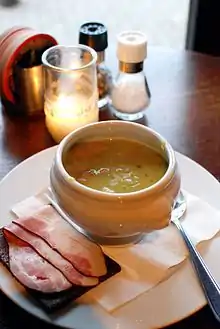
Dinner, traditionally served early by international standards, starts around or even before 6 p.m. It is not uncommon for restaurants outside of major cities to be closed by 8 p.m. The old-fashioned Dutch dinner for the lower class consists of one simple course: potatoes, meat and vegetables—known under the acronym "AVG" (aardappelen, vlees, groente). AVG consists traditionally of potatoes with a large portion of vegetables and a small portion of meat with gravy, or a potato and vegetable stew. Vegetable stews served as side dishes are for example rodekool met appeltjes (red cabbage with apples), or rode bieten (beetroot). Regular spices used in stews of this kind may be bay leaves, juniper berries, cloves, and vinegar, although strong spices are generally used sparingly. Stews are often served with pickles, including gherkins or cocktail onions (zilveruitjes). Due to the influx of other countries, traditional meals have lost some popularity. Stamppot, mashed potatoes with different options for vegetables, is traditionally eaten in winter. If there is a starter, it is usually soup.
The below-listed meals have historic origins as meals for common labourers. From the 17th to the 19th century workers worked 10 to 16 hours on farms or in factories in unheated rooms, hence these meals are very heavy on calories and fat and were meant to replenish a laborer's energy.
- Stamppot, boiled potatoes mashed with vegetables and served with meat and/or gravy, coming in a number of varieties:
- Boerenkoolstamppot, curly kale (boerenkool) mixed with potatoes, served with bacon, gravy, mustard, and rookworst (smoked sausage). It is one of more popular Dutch dishes. It is the classic stamppot, and thus when people only say 'stamppot' they mean the curly kale variant. Boerenkoolstamppot was mentioned in cookbooks from the year 1661. Mashed potatoes were not used in this dish at that time, although the sausage was already served with the cabbage in this dish. The dish became popular after a few bad corn seasons, when potatoes became popular as food. Boerenkoolstamppot is high in carbohydrates, which makes it a popular meal for cold winter days.
- Hutspot, made with potatoes, carrots, and onions served with slow-cooked meat and bacon. Before potatoes were introduced in Europe hutspot was made from parsnips, carrots, and onions. The dish plays a central role during 3 October Festival in the city of Leiden..
- Andijviestamppot, raw endive mashed with hot potatoes, served with diced fried spek (a kind of bacon).
- Hete bliksem ("hot lightning"), boiled potatoes and green apples, served with stroop (treacle) or tossed with diced speck.
- Zuurkool, sauerkraut mashed with potatoes. Served with fried bacon or a sausage. Sometimes curry powder, raisins or slices of pineapple or banana are used to give a stamppot an exotic touch.
- Snert, also called erwtensoep, is a very thick pea soup that can be served either as a main dish or as an appetizer and is traditionally eaten during the winter. Snert includes pieces of pork and rookworst and is almost a stew rather than a soup. It is often said that "...you should be able to stand a spoon upright in a good pea soup".[35] It is customarily served with roggebrood (rye bread) spread with butter and topped with katenspek, a variety of bacon which is first cooked and then smoked. The meat from the soup may also be put on the rye bread and eaten with mustard.

Meat dishes
- Gehaktballen (meatballs, usually half pork, half beef).
- Slavink, minced meat wrapped in bacon.
- Balkenbrij, a type of liverwurst and meatloaf. The butter-based gravy (boterjus) in which the meat has been fried or cooked is also served. A variant of this, eaten around the IJsselmeer, is butter en eek, where vinegar is added to the gravy.
Flour & diary dishes
- Pannenkoeken (large and thin pancakes) with bacon, apples, cheese, or raisins.
- Poffertjes (miniature pancakes) and spekdik (a Northern variant with bacon).
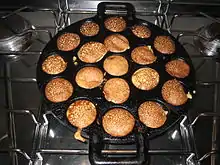 Poffertjes are made in a special, so-called poffertjespan.
Poffertjes are made in a special, so-called poffertjespan. - Wentelteefjes (French toast).
- Broeder, a type of boiled pudding usually containing buckwheat, is a traditional dinner mainly in West Friesland.
Seafood
- Zeeuwse mosselen (a mussel dish, so called because mussels are cleaned and sold in Yerseke, in the province of Zeeland) are popular and commonly served with French fries.
- Kibbeling, chunks of sea fish that are battered and fried.
Toetje

Het toetje, or the final course is a sweet dessert, traditionally yogurt with some sugar or vla, a thin milk pudding (cooked milk with custard). Other desserts include:
- Vla-flip, vanilla vla mixed with yogurt
- Broodpap, a bread porridge made from old bread, milk, butter, and sugar.
- Griesmeelpudding, a sweet pudding made of semolina and served with red berry coulis.
 Griesmeelpudding (semonila pudding) served with rodebessensaus (red berry coulis)
Griesmeelpudding (semonila pudding) served with rodebessensaus (red berry coulis) - Grutten (Groat)
- Haagse bluf
- Hangop (Strained yogurt)
- Karnemelkse bloempap
- Karnemelkse gortepap
- Rijstebrij (rice pudding)
- Krentjebrij (also called watergruwel)
- Broeder
Special occasions
Birth and death
The birth of a child is an occasion for serving beschuit met muisjes (Dutch rusk covered with sugared aniseed). Traditionally, Dutch funerals are sober, and food provided is a simple piece of cake with a cup of coffee or tea.
Sinterklaas


The Dutch festival of Sinterklaas is held on 5 December. Saint Nicholas leaves gifts in the children's shoes. On this occasion, the Dutch drink hot chocolate milk and eat luxury variants of speculaas: speculaasbrokken (thick speculaas chunks) and gevulde speculaas (almond paste filled speculaas). Spices in speculaas include cinnamon, cloves, nutmeg, cardemon and ginger. Also boterletter (a baked pastry crust with an almond paste filling and shaped into a letter S of Sinterklaas), marsepein (marzipan, in the shape of animals or other topical items), borstplaat (discs of fondant); and taaitaai are eaten. And everyone receives a chocoladeletter (chocolate letter), corresponding with the first letter of the name of the receiver. Special treats distributed by Saint Nicholas' aide Zwarte Piet include pepernoten (irregularly shaped small cookies made of rye, honey and anise) and kruidnoten (gingernut-shaped biscuit but made with speculaas spices). The traditional kruidnoot has a specific flavor and texture, but over the years, various variants have also entered the market. Some examples of variants that have appeared in Dutch stores:
- Chocoladekruidnoten: These are kruidnoten covered with a layer of milk chocolate, dark chocolate, or white chocolate.
- Truffelkruidnoten: These have a rich chocolate flavor and are covered with a thin layer of cocoa powder.
- Gevulde kruidnoten: This variant has a filling in the center. Popular fillings include chocolate, caramel or marzipan.
- Yoghurtkruidnoten: These kruidnoten are coated with a layer of yogurt. They have a fresh and creamy taste.
- Koffiekruidnoten: These are kruidnoten with a subtle coffee flavor. They are often coated with a layer of coffee glaze.
Christmas
Christmas (Kerst) in the Netherlands is a typical family holiday. Traditionally there is family brunch with kerststol, a fruited raisin bread, often filled with almond paste and covered in powdered sugar. A popular sweet is kerstkransje. Christmas dinner is also a family occasion where rollade (a kind of roulade but without the filling, consisting of spiced pork), roast pork, game, or other luxury meat may be served. Another popular Christmas dinner tradition is gourmetten, where people cook on the dinner table their own food on a special gourmetset, although this is not limited to Christmas.

New year
On New Year's Eve (Oud en Nieuw), Dutch houses smell of the piping hot oil of deep-fat fryers used to prepare oliebollen and appelbeignets (a kind of apple fritter) – not to be mistaken for the appelflap which are made of puff pastry. Also ananasbeignets (pineapple fritter) are considered a treat. Oliebollen are yeast dough balls, either plain or filled with glacé fruits, apple pieces, raisins, and sultanas are served with powdered sugar. They are sold by street vendors and bakeries, and the quality can vary by a land slide and every year an oliebollen contest is held.[36] Freshly made they are the most tasty. In the 17th century, Dutch settlers also took their oliebollen to the American colonies, where they are now known in a different form and recipie as doughnuts.
In Limburg, nonnevotten are sometimes served during New Year's Eve, although it is mostly eaten during Carnival. Around New Years knieperties are popular, in particular in the northern provinces.
Fast food
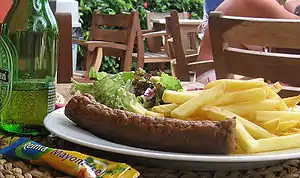

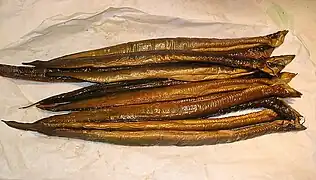
Snackbars
The Dutch have their own types of fast food, sold at snackbars that mainly serve deepfried fastfood. French fries (called patat or friet) are served with one or a combination of sauces:
- patatje met (mayonaise or fritessaus)
- patatje pinda (peanut sauce)
- patatje ketchup (or curry ketchup)
- patatje speciaal (mayonnaise, (spiced) ketchup, chopped raw onions)
- patatje oorlog (peanut sauce, mayonnaise, chopped raw onions)
- patatje joppie (pickle relish of chopped vegetables and mild spices
- patatje kapsalon (fries, topped with either shawarma, kebab, or döner kebab, finished with salad, cheese, and various sauces such as sambal and garlic sauce.
Snacks made with meat are usually deep fried. These include:
- frikandel, deep-fried skinless minced meat sausage, most popular fast food snack in the Netherlands
- kroket, deep-fried ragout roll covered in a thick crust, eaten with mustard, also available in bread rolls (broodje kroket). The two main varieties are rundvleeskroket (with beef) and kalfsvleeskroket (with veal). Vegan, cheese and satay versions are also available. The thick, crispy crust, the bigger size and the filling sets the Dutch kroket apart from the French croquette (where it originates from) and Spanish croquetas. An estimated 75% of all Dutch people eat them, resulting in 29 kroketten per person per year on average, being the 2nd most popular Dutch snack after the frikandel.[38] In some municipalities, members of the municipal council have the right to a kroket if a council meeting lasts until after 23:00.[39]
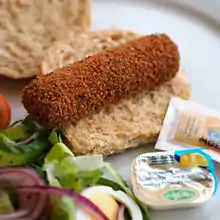 A broodje kroket served for lunch.
A broodje kroket served for lunch. - bamischijf and nasischijf, deep-fried disk shaped mie goreng or nasi goreng patties covered with breadcrumbs.
- kaassoufflé, deep fried puff pastry envelope with a small amount of Gouda cheese in the center
- Berenklauw, sliced meatball and fried onion rings on a wooden skewer, smothered in peanut sauce
- Kipcorn, deep fried rod-shaped chicken or turkey meat slurry, breaded with a crust of corn or breadcrumbs, served with ketchup, mayonnaise or curry sauce
- Speciaaltje, deep-fried spiced minced meat covered in breadcrumbs
- eierbal, regional (in the north and east of the country), a deep-fried egg in ragout
On the road
- Saucijzenbroodje (kind of sausage roll), slightly spiced sausage meat baked in pastry, are sold in supermarkets and kiosks
- Brabants worstenbroodje, regional (Brabant), slightly spiced sausage meat baked in bread
Fish stalls
- rauwe haring or zoute haring (soused herring), optionally served with chopped raw onions and gherkins, which is eaten by lifting the herring high up into the air by its tail and then biting into it upwards (except for Amsterdam, where the herring is cut into pieces). Raw herring is also commonly sold in a soft white bun.
- kibbeling, deep-fried, nugget-sized chunks of (originally) Atlantic cod, but now often replaced by cheaper other kinds of whitefish. It is often served with remoulade, garlic sauce or tartar sauce, and seasoned with a mix of grounded herbs, such as coriander, pepper, paprika, garlic, onion chilli etc.
 Kibbeling are popular as a snack.
Kibbeling are popular as a snack. - lekkerbekje, deep-fried cod (or other whitefish), similar to the British fish and chips, but delicately spiced and with a more tempura-like batter
- gerookte paling (smoked European eel) has a long standing tradition in the Netherlands, particularly around IJsselmeer.
Gallery
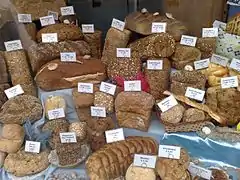 Bread comes in many varieties.
Bread comes in many varieties.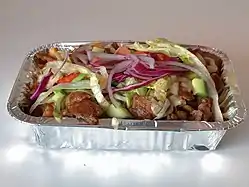
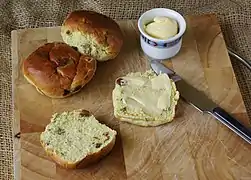 Krentenbollen are eaten with butter or cheese for breakfast, lunch, or as a snack.
Krentenbollen are eaten with butter or cheese for breakfast, lunch, or as a snack.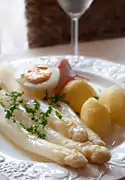 A seasonal dish, asparagus is popularly eaten with ham, egg, and potatoes, with a butter sauce.
A seasonal dish, asparagus is popularly eaten with ham, egg, and potatoes, with a butter sauce.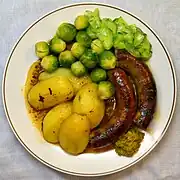 A simple Dutch meal traditionally consists of meat, potatoes, butter, a boiled vegetable, and salad.
A simple Dutch meal traditionally consists of meat, potatoes, butter, a boiled vegetable, and salad.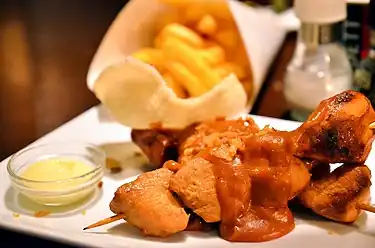 Satay, originally an Indonesian dish, is commonly served with chips in the Netherlands.
Satay, originally an Indonesian dish, is commonly served with chips in the Netherlands. Babi panggang speciaal was, although seemingly Indonesian-Chinese in origin, possibly devised in the Netherlands.
Babi panggang speciaal was, although seemingly Indonesian-Chinese in origin, possibly devised in the Netherlands. Broodje bakkeljauw is a Dutch-Surinamese bun containing dried and salted cod, here with a chili dip made from Madame Jeanette chili peppers.
Broodje bakkeljauw is a Dutch-Surinamese bun containing dried and salted cod, here with a chili dip made from Madame Jeanette chili peppers. Mussels (Mosselen met friet) are usually served with chips and dipping sauces
Mussels (Mosselen met friet) are usually served with chips and dipping sauces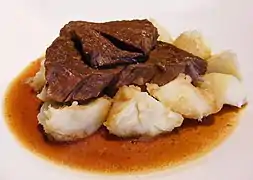 Sudderlapjes is slowly simmered beef, most often served with potatoes.
Sudderlapjes is slowly simmered beef, most often served with potatoes.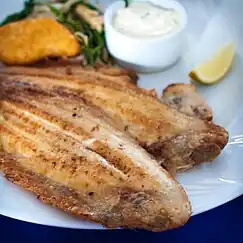 Gebakken sliptong: young sole (also known as "slip") fried in butter.
Gebakken sliptong: young sole (also known as "slip") fried in butter. A nasischijf cut open showing the fried rice inside the deep fried snack
A nasischijf cut open showing the fried rice inside the deep fried snack Hutspot with beef
Hutspot with beef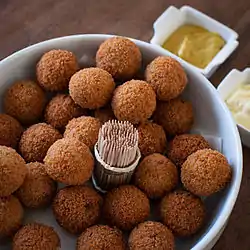 Bitterballen are small snacks similar to the larger kroketten and are usually served with mustard.
Bitterballen are small snacks similar to the larger kroketten and are usually served with mustard.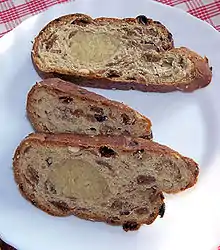 Slices of kerststol showing the almond paste in the middle.
Slices of kerststol showing the almond paste in the middle.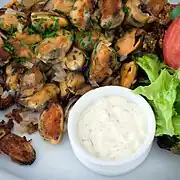 Gebakken mosselen (fried mussels) are cooked mussels fried with butter and onions.
Gebakken mosselen (fried mussels) are cooked mussels fried with butter and onions.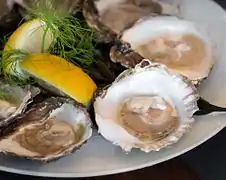 Raw oysters, which are "platte zeeuwse oester".
Raw oysters, which are "platte zeeuwse oester".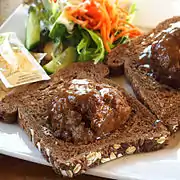 Broodje bal, a slice of bread with a meatball and gravy, halved meatball served on slices of Dutch whole wheat bread.
Broodje bal, a slice of bread with a meatball and gravy, halved meatball served on slices of Dutch whole wheat bread. Slices of meat with hard-boiled eggs in the middle.
Slices of meat with hard-boiled eggs in the middle.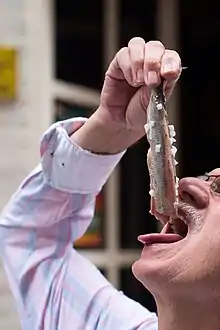 Eating "Hollandse Nieuwe" (Dutch brined herring) the Dutch way.
Eating "Hollandse Nieuwe" (Dutch brined herring) the Dutch way.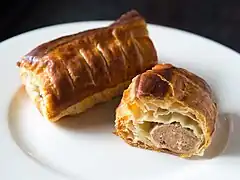 A saucijzenbroodje is a popular snack in the Netherlands and is a variant of a sausage roll.
A saucijzenbroodje is a popular snack in the Netherlands and is a variant of a sausage roll.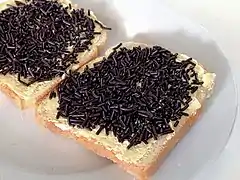 Bread with butter and hagelslag.
Bread with butter and hagelslag.
See also
- Wannée Kookboek (1910– )
- Nieuwe Haagse Kookboek (1934– )
- List of Dutch chefs
- Beer in the Netherlands
- Dutch cheese markets
- FEBO – a chain of fast food outlets using vending machines to serve krokets, frikandellen, kaassoufflés, and other items
- Pannenkoek – a Dutch pancake
- Stroopwafel – a Dutch waffle
- Babi panggang – a Dutch/Indonesian/Chinese fusion dish
- Spekkoek – a Dutch/Indonesian cake
- Coleslaw – from the Dutch words "kool" (cabbage) and "sla" (salad)
- Rijsttafel – Dutch for rice table. Indonesian styled dish. Side dishes served in small portions, accompanied by rice prepared in several different ways
- Hollandse Nieuwe – fresh (raw) herring
References
- Ukers, William Harrison (1935). All about Coffee. Library of Alexandria. p. 568. ISBN 978-1-4655-2397-6.
- "History of Chocolate: Cocoa Beans & Xocolatl". HISTORY. 10 August 2022. Retrieved 22 June 2023.
- Mecking, Olga. "The Netherlands Can Feed the World. Here's Why It Shouldn't". yes magizine. Retrieved 4 June 2022.
- Reiley, Laura. "Cutting-edge tech made this tiny country a major exporter of food". Washington Post. Retrieved 31 May 2023.
- "Eten door de eeuwen". Verhalenwerf (in Dutch). Retrieved 13 October 2023.
- Kiple, Kenneth F. (2 August 2017). The Cambridge world history of food. 2. Cambridge University Press. ISBN 978-0-521-40215-6. Retrieved 2 August 2017 – via Google Books.
- "Hoppenbier (1300-1500) - Nederlandse Biercultuur". www.nederlandsebiercultuur.nl. Retrieved 13 October 2023.
- Netherlands, Statistics (20 July 2021). "The Netherlands is the largest beer exporter in the EU". Statistics Netherlands. Retrieved 16 October 2023.
- "William Buckels". aboutus.org.
- "Dutch Food & Eating Out – Holland.com". holland.com. 10 October 2012.
- "The Fishy History of Dutch Herring". the low countries. Retrieved 4 June 2023.
- DBNL. "Een notabel boecxken van cokeryen · dbnl". DBNL (in Dutch). Retrieved 4 September 2019.
- DBNL. "Een notabel boecxken van cokeryen · dbnl". DBNL (in Dutch). Retrieved 4 September 2019.
- "Kantoor of bedrijfsruimte huren in Rotterdam of Zwolle". wereldexpat.nl. Archived from the original on 23 December 2008. Retrieved 21 May 2015.
- "Gastronomie: De Nederlandse keuken". Antiqbook.nl. Archived from the original on 28 September 2007. Retrieved 2 August 2017.
- "The History of Sugar – Aronson Antiquairs of Amsterdam | Delftware | Made in Holland". Retrieved 20 October 2023.
- "Spices and the Spice Trade | Encyclopedia.com". www.encyclopedia.com. Retrieved 21 October 2023.
- Manon (18 November 2016). "Koken in de Gouden Eeuw". eetverleden (in Dutch). Retrieved 21 October 2023.
- Ukers, William H (1922). "The Introduction of Coffee into Holland". All About Coffee. New York: Tea and Coffee Trade Journal. ISBN 0-8103-4092-5. Retrieved 12 February 2010.
- Dobelis, Inge N, ed. (1986). Magic and medicine of plants. Pleasantville, NY: Reader's Digest. pp. 370–371. ISBN 0-89577-221-3.
- Fischer, Dieter. "History of Indonesian coffee". Specialty Coffee Association of Indonesia. Archived from the original on 5 August 2009. Retrieved 12 February 2010.
- "Nederlands BakkerijMuseum". Bakkerijmuseum.nl. Retrieved 2 August 2017.
- "Archived copy" (PDF). Archived from the original (PDF) on 21 December 2013. Retrieved 16 January 2015.
{{cite web}}: CS1 maint: archived copy as title (link) - De verstandige kok. Marleen Willebrands ISBN 9077455205
- Karin Engelbrecht. "Kastelenkookboek Cookbook Review". About.com Food. Retrieved 21 May 2015.
- Wintle, Michael (2006). "Diet and Modernization in the Netherlands During the Nineteenth and Early Twentieth Centuries". In Thomas M. Wilson (ed.). Food, Drink and Identity in Europe. Rodopi. pp. 63–84. ISBN 9789042020863. Retrieved 28 December 2012.
- Thea Spierings (2008). Dutch Cuisine: Discover the Secrets of the Dutch Kitchen. Miller Books. ISBN 978-9087240868.
- C. Countess van Limburg Stirum: The Art of Dutch Cooking; First published in 1962 by Andre Deutsch Limited, London; p.179-p.185
- "The Chinese-Indonesian restaurant culture". Immaterieel Erfgoed. Retrieved 9 June 2023.
- "10 Best Dutch Foods to try when in Holland". Explore Holland. 31 January 2020. Retrieved 31 January 2020.
- "Is jouw stuk kaas wel echt jong, belegen of oud?". npo3.nl. Retrieved 11 June 2023.
- "Anijsmelk". Thedutchtable.com. Retrieved 2 August 2017.
- "Which Country Eats The Most Licorice?". Licorice.com. 29 November 2022. Retrieved 9 June 2023.
- Heckmann, Chris (28 April 2022). "The Top 10 Breweries in Amsterdam". Around The World With Me. Retrieved 5 January 2023.
- Hester, Carla Dutch food and eating habits The Holland Ring, 28 October 2008
- "Home". oliebollentestonline (in Dutch). Retrieved 10 June 2023.
- Hove, Sam ten (23 March 2016). "Nederlander eet gemiddeld 47 paaseieren". Metronieuws.nl (in Dutch). Retrieved 10 June 2023.
- "Nederland neemt een betere kroket - Foodlog". foodlog.nl.
- "Ten Fun Facts About the Dutch Croquette". the low countries. Retrieved 10 June 2023.
External links
- Dutch food and eating habits
- Hutspot recipe
- The Dutch Table – an online resource for Dutch recipes
- Food of the Dutch Photo-documentary by photographer Wim Klerkx, 2005–2007
